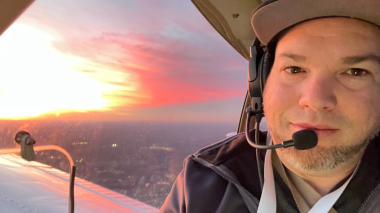At age 75, Joan Brennan found herself completely exhausted and constantly out of breath. These symptoms were especially difficult for her since she was an avid walker and loved spending time in her garden. “It was very difficult to walk without hanging on to something,” Joan says. “I couldn't even walk to the end of the block.”
Joan’s aortic stenosis, which was diagnosed in 2019, had progressed to stage III heart failure. In early 2022, Joan’s cardiologist recommended an aortic valve replacement and referred her to Dr. Michael Rinaldi, interventional cardiologist and medical director of the Structural Heart Program at Atrium Health Sanger Heart & Vascular Institute.
Since Joan lived alone, she was concerned about planning for her recovery if she needed major surgery. Due to her age and condition, Rinaldi recommended a transcatheter aortic valve replacement (TAVR). This procedure allowed the surgical team, which included Rinaldi, a cardiovascular surgeon, to replace her aortic valve using a catheter-based approach instead of open-heart surgery.
The heart failure team has been performing TAVR procedures for the past decade. Joan’s procedure was Sanger Heart & Vascular Institute’s 2,022nd TAVR procedure.
“Aortic stenosis touches a lot of people's lives, and our TAVR treatment can dramatically improve their survival rate,” says Rinaldi. “We've refined this therapy over time to become something that is very safe and effective.”
TAVR has become the first-line therapy for patients with aortic stenosis, particularly for those over 70 years of age. The procedure is associated with low rates of mortality, stroke, bleeding and kidney failure. In addition, most TAVR patients can return home the next day to complete their recovery, which tends to be much quicker than a surgical recovery.
“As patients get older, they don't want to go through a big operation and spend a lot of the life they have left recovering,” says Rinaldi. “Shorter recoveries mean we’re giving patients more quality years. It's satisfying when we can bring them back to their families and get them productive again.”
Why it’s Needed
Aortic stenosis occurs when the valve, which controls blood flow between the heart and the rest of the body, thickens and calcifies. This condition tends to affect elderly patients, but it can also affect those who are middle-aged.
As the valve becomes progressively narrower, the heart must pump harder to push the blood through an increasingly smaller opening. This causes pressure to build up in the heart and lungs, which makes the patient short of breath. Within a few years, the condition can lead to heart failure.
Since aortic stenosis is a mechanical problem, valve replacement is the only feasible treatment. Historically, this was done through surgery.
“The problem is that many elderly patients aren’t healthy enough for open-heart surgery,” says Rinaldi. “And most patients want to avoid heart surgery when they can, because it's a big commitment with a lot of risk and recovery time involved.”
During the procedure, the new valve is placed in a stent, which is inserted into the patient’s leg artery using a catheter. The heart failure team tracks the catheter’s movement through the patient’s circulatory system using X-ray cameras and places it across from the narrowed aortic valve. Once in place, the stent is expanded, propping open the new valve. Thus, the patient’s narrow valve becomes the structure to hold the stent in place.
TAVR is beneficial for patients who do not qualify for heart surgery. But it can also help patients who could have heart surgery but would likely have a higher mortality and spend a lot more time in the hospital. These patients run the risk of never getting their functional capacity back. Additionally, it’s an alternative procedure for younger, healthier patients who are good surgical candidates but who want to return to their lifestyles quicker following valve replacement.
Highly Rated Program
“We’ve been the busiest TAVR center in the Carolinas since the valve became commercially available 10-years ago,” says Dr. John Fredrick, chief of the division of cardiovascular surgery at Sanger Heart & Vascular Institute. “That's important because a multitude of studies show that higher volumes translate to better quality and a lower risk of complications.”
Because of this experience, the TAVR team was selected by Edwards Lifesciences to host a training course for providers from other regional valve replacement programs. During the course, the providers learned how to improve the efficiency of TAVR procedures.
Sanger Heart & Vascular Institute’s TAVR program has earned the 5-star program rating from U.S. News & World Report, making it one of only three centers to receive this designation in the Carolinas. It also received a 3-star rating from the Society of Thoracic Surgeons/ American College of Cardiology Transcatheter Valve Therapy Registry. The TAVR program is one of only a small number of programs in the U.S. to receive the highest ratings from both organizations.
“We have improved patient care by taking several specialties that were doing good work and bringing them together to collaborate even closer than they were before,” says Rinaldi. “We see patients together and discuss them in a combined conference each week. As we review their histories and imaging, we work together to identify the therapies that will work best for them.”
In addition to the team’s exceptional surgeons, cardiologists and imagers, Rinaldi is grateful to the nurse navigators and advanced care practitioners who take care of the details and get TAVR patients through the process safely.
Safe and Confident Care
Thanks to Sanger Heart & Vascular Institute’s dedication to leading-edge research, Joan was able to enroll in a clinical trial for a new type of aortic valve technology that’s widely used in Europe. This new valve significantly reduced Joan’s risk of needing a permanent pacemaker, which, in turn, helped reduce her anxiety levels. Plus, as a trial patient, she was glad to receive extra testing and attention from the medical staff.
Joan noticed an immediate improvement after her procedure. In fact, she was able to stand up and walk without any feeling of weakness or shortness of breath. She recovered at home and started cardiac rehabilitation a few weeks later.
Joan says the team at Sanger Heart & Vascular Institute was kind and thoughtful and took the time to answer her questions.
“They were very understanding of the challenges patients face, both medically and emotionally,” says Joan. “That was so refreshing to me. I felt safe and confident at all times.”
Following her recovery, Joan says she returned to “serious walking” and can get her heart rate up to 135 without any pain or shortness of breath.
“It's like the old Joan is back,” she says.
The TAVR team is currently studying the long-term durability of the technology and planning for the lifetime management of valve replacements.
“Our catheter valves have at least a 10-year follow-up period with yearly echocardiography required,” says Rinaldi. “So, over time, we'll get excellent data – not just on the durability of the catheter valves but also on the surgical valves.”
“For patients like Joan, who are over the age of 70, the rapid recovery from TAVR procedures outweighs any question about durability,” says Frederick.
TAVR is available at Atrium Health Carolinas Medical Center and Atrium Health Cabarrus. Learn more about Sanger Heart & Vascular Institute’s heart care.



